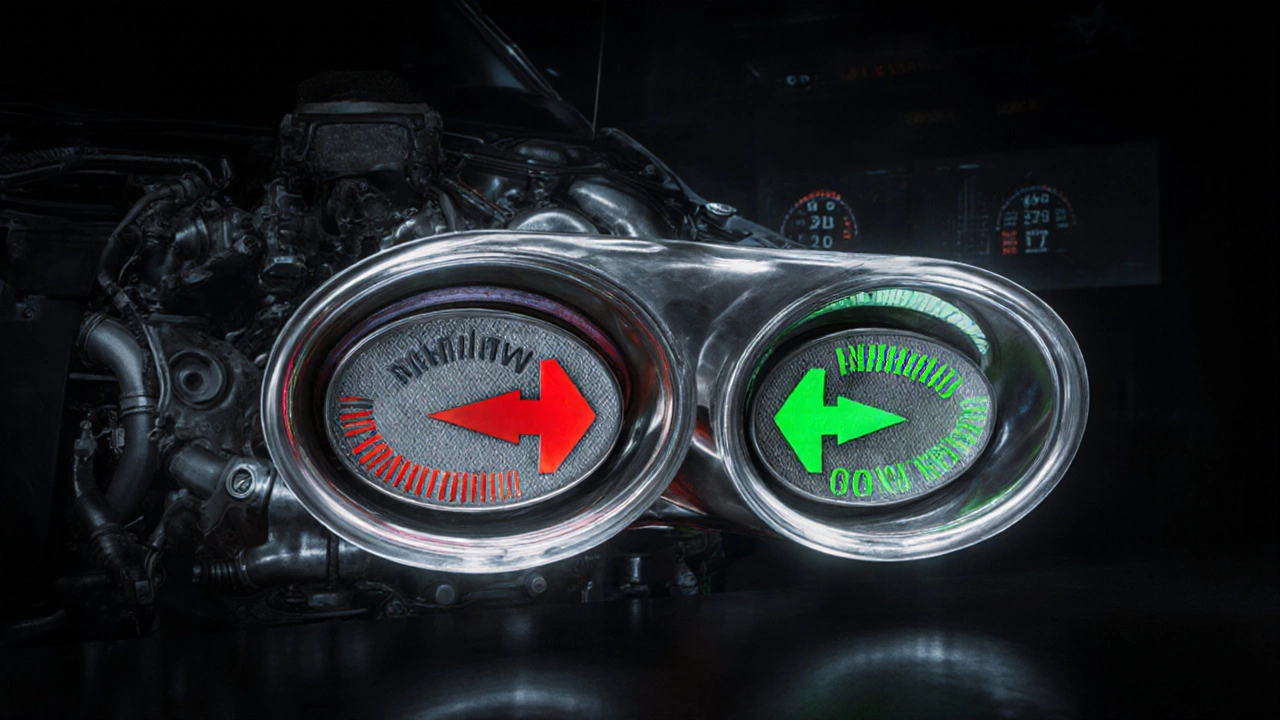MagnaFlow Horsepower Gain Calculator
Your Vehicle Details
Your Results
When you hear the deep rumble of a MagnaFlow muffler rolling down the street, it’s easy to assume it’s giving your car more power. But does it actually increase horsepower-or is it just loud? The answer isn’t simple. It depends on your car, your stock exhaust, and what you’re really trying to fix.
How exhaust systems affect engine performance
Your engine doesn’t just make power-it makes exhaust gases. If those gases can’t escape quickly, they back up and choke the engine. Think of it like trying to breathe through a straw while running. That’s what a clogged or restrictive exhaust does. A better-flowing exhaust system reduces this backpressure, letting the engine breathe easier. That’s where performance mufflers like MagnaFlow come in.
MagnaFlow mufflers use a straight-through design with perforated tubing wrapped in stainless steel wool. Unlike traditional mufflers with baffles and chambers that restrict flow, MagnaFlow’s design lets exhaust gases move with less resistance. Less restriction = less work for the engine = potential power gains.
How much horsepower does a MagnaFlow muffler actually add?
Don’t believe the 50-horsepower claims you see on YouTube. Real-world dyno tests show something different. For most stock cars, swapping just the muffler for a MagnaFlow adds between 5 and 10 horsepower. That’s it. Not because the muffler is weak, but because the rest of the exhaust system-the headers, catalytic converters, and piping-is still restrictive.
Take a 2020 Ford F-150 with the 3.5L EcoBoost. A MagnaFlow replacement muffler alone added 8 hp and 12 lb-ft of torque at the wheels, according to tests by Car and Driver. That’s noticeable when accelerating from a stop, but you won’t feel it on the highway. Now, swap the whole exhaust system-headers, mid-pipe, muffler-and that same truck gains 30+ hp. The muffler is only part of the story.
Smaller cars like a Honda Civic or Toyota Corolla see even less gain-often just 3 to 6 hp. Why? Their factory exhausts are already fairly free-flowing. The biggest gains come from trucks, SUVs, and older muscle cars with heavily restricted stock systems.
What MagnaFlow mufflers actually improve
Even if the horsepower gain is small, MagnaFlow delivers real benefits:
- Better throttle response-the engine feels livelier off idle because exhaust isn’t backing up.
- Improved fuel economy-in some cases, up to 1-2 mpg, especially during highway cruising. Less backpressure means the engine doesn’t have to work as hard.
- Deeper, cleaner sound-no rasp, no drone. MagnaFlow’s design reduces harsh frequencies while keeping a rich tone. Many owners say it sounds more premium than stock.
- Longer lifespan-stainless steel construction resists rust. Many MagnaFlow mufflers last the life of the vehicle.
These aren’t flashy numbers, but they’re the kind of improvements you notice every day-not just on a dyno chart.

When a MagnaFlow muffler won’t help
Don’t expect miracles if:
- Your car has a factory performance exhaust (like a Subaru WRX or Ford Mustang GT). The stock system is already optimized.
- You’re running a turbocharged engine with a restrictive catalytic converter. The muffler isn’t the bottleneck-the cat is.
- Your engine is tuned for emissions, not power. Modern cars with aggressive fuel maps and ECU limits won’t respond much to exhaust changes alone.
- You’re chasing big gains on a 15-year-old sedan. The engine’s design limits power more than the exhaust.
In these cases, you’ll need a full cat-back system, high-flow catalytic converters, or even an ECU tune to unlock real performance.
Real owner experiences
One owner of a 2018 Chevrolet Silverado 1500 with the 5.3L V8 reported a 7 hp gain on his dyno test after installing a MagnaFlow muffler. He also noticed his truck ran cooler on long hauls and got 1.5 mpg better fuel economy. He didn’t feel like he had a new car-but he did feel like he’d fixed a quiet, sluggish exhaust.
Another driver swapped his 2016 Nissan Altima’s stock muffler for a MagnaFlow. He expected a power boost. Instead, he noticed the engine sounded smoother, the cabin was quieter at highway speeds, and his fuel economy jumped from 27 to 29 mpg. He kept it because it made driving more pleasant-not because it was faster.
These aren’t outlier stories. They’re common. MagnaFlow doesn’t turn your car into a drag racer. It turns a tired, noisy exhaust into a clean, efficient one.

Comparison: MagnaFlow vs. stock vs. full performance system
| Upgrade Type | Horsepower Gain | Torque Gain | Fuel Economy Change | Sound Quality |
|---|---|---|---|---|
| Stock OEM muffler | 0 hp | 0 lb-ft | Baseline | Muted, sometimes droning |
| MagnaFlow muffler only | 5-10 hp | 8-15 lb-ft | +1-2 mpg | Deep, resonant, no rasp |
| Full cat-back system | 20-40 hp | 25-50 lb-ft | +1-3 mpg | Loud, aggressive, performance tone |
| Full system + tune | 40-70 hp | 50-90 lb-ft | +2-4 mpg | Powerful, commanding |
As you can see, the muffler alone gives you about half the gains of a full system-but at a fraction of the cost. For most drivers, it’s the smartest upgrade.
Is it worth it?
If you want:
- A better sound without drone or rasp
- Minor but real gains in throttle response and fuel economy
- A durable, rust-free muffler that won’t need replacing
Then yes-a MagnaFlow muffler is worth it. It’s one of the few exhaust upgrades that delivers on its promises without overselling.
If you want 50+ extra horsepower, you’ll need more than a muffler. You’ll need headers, a high-flow catalytic converter, and likely a tune. But that’s a $2,000+ project. A MagnaFlow muffler costs under $300 and installs in a few hours.
It’s not a magic bullet. But it’s one of the most honest upgrades you can make.
Do MagnaFlow mufflers increase horsepower on all cars?
No. The gains are smallest on modern, factory-tuned cars with already-efficient exhausts. Trucks, SUVs, and older muscle cars see the most benefit. Smaller sedans often gain only 3-6 hp, if any. The engine’s design and existing exhaust restrictions determine the outcome.
Will a MagnaFlow muffler make my car louder?
Yes, but not in a bad way. MagnaFlow mufflers produce a deeper, richer tone-not the high-pitched rasp of cheap performance mufflers. Many owners say it sounds more premium than stock. At highway speeds, cabin drone is minimal thanks to the straight-through design.
Can I install a MagnaFlow muffler myself?
Yes, if you have basic tools and a jack. Most MagnaFlow mufflers are direct replacements, using the same hangers and mounting points as the stock unit. Installation typically takes 1-2 hours. No welding is required. Instructions and all hardware are included.
Does a MagnaFlow muffler affect emissions or pass inspection?
Yes, if you only replace the muffler. MagnaFlow mufflers are designed to work with your factory catalytic converter. They don’t remove emissions controls, so they won’t trigger a check engine light or cause you to fail emissions testing in any U.S. state or the UK.
How long do MagnaFlow mufflers last?
With stainless steel construction and no internal packing that breaks down, MagnaFlow mufflers typically last the life of the vehicle. Many owners report 15+ years of use without rust or failure. That’s far longer than most OEM or budget aftermarket mufflers.
Should I upgrade the whole exhaust system instead?
Only if you want maximum power and don’t mind spending $1,500-$3,000. A full cat-back system gives 2-4 times the horsepower gain of a muffler swap. But for most drivers, the muffler alone delivers 80% of the benefits-sound, efficiency, and durability-at 20% of the cost.






